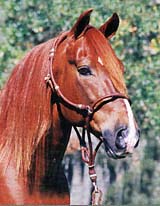Peruvian Paso
N/A
Mon, 25th November, 2024 - 11:31 pm GMT
Sponsor Ads:

Alternative Name
N/ABasic Info
Physically, the Paso is a horse of medium size, usually standing between 14.1 and 15.2 hands tall, with a powerful build. He may be chestnut, black, brown, bay, buckskin, palomino, gray, roan or dun; with the solid colors, grays and dark skin considered most desirable. The mane is abundant with fine, lustrous hair that may be curly or straight. Horses must be shown unshod. The Peruvian Paso horse should have an appearance of energy, grace and refinement. Horses should have a well-developed muscular appearance without exaggerations. The head is of medium size with a straight or slightly concave profile; a small muzzle; oblong nostrils which extend easily; dark skin; dark expressive eyes set well apart; moderately marked jowls and medium length ears with fine tips curved slightly inward. The neck is of medium length with a graceful arch to the crest. It is slightly heavier in proportion to the body than with most light saddle breeds. The back is medium to short in length, strong and rounded. Loins broad and well muscled over kidney area. Croup long and wide, fairly muscular with moderate slope and nicely rounded. Tail is set low and viewed from the rear is carried straight, quietly and held close to the buttocks. Chest is wide with abundant muscling. Rib cage well sprung and deep. The barrel is deep and the underline is nearly level from the last rib to the brisket. Flanks are moderately short, full and deep. Quarters should be strong, of medium roundness and width. Shoulders long, very well inclined and well muscled, especially at the withers. Bones of the lower limbs should be well aligned and well articulated so that the long bones line up with each other correctly above and below the joints with the skin tight against the bone and strong, prominent tendons. Pasterns of medium length and springy but not showing weakness. Cannon bones are short. Slightly more angle to the hock than other light saddle breeds.
Health
N/AHabitat
N/ABehavior
Perhaps the most misunderstood of all traits that distinguishes the Peruvian horse is "brio," a quality of spirit that enables this tractable horse to perform with an arrogance and exuberance that can only be described as thrilling. "Brio" and stamina give the Peruvian its willingness and ability to perform tirelessly for many hours and many miles in the service of its riderOrigin
PeruHistory
Although a newcomer to North America, the Peruvian Paso had its origins over four centuries ago in South America, where the horses brought to Peru by the conquistadors and subsequent Spanish settlers were bred selectively to produce the genetic miracle that became the "National Horse of Peru." The judicious fusion of several Old World breeds provided the foundation for the Peruvian horse. The Spanish Jennet gave its even temperament and smooth ambling gait, the African Barb contributed great energy, strength and stamina while the Andalusian imparted its excellent conformation, action, proud carriage and beauty to the new breed. Once established, the Peruvian Paso was maintained in its native country as a closed population, isolated by geography and the dedication of its creators from the influence of additional outside blood.Common Foods
grassSponsor Ads:
"There is nothing either good or bad, but thinking makes it so". -- Hamlet Act II, Sc. II, William Shakespeare
Peruvian Paso
Coded by: BGID® | ALL RIGHTS RESERVED Copyright © 2000-2024
Disclaimer | Privacy | Report Errors / Contact | Credits








 President of the United States of America - Real Estate mogul, Pageant owner and now one of the most controversial men in political history.
President of the United States of America - Real Estate mogul, Pageant owner and now one of the most controversial men in political history.  Politician, US Vice President and President of the USA - Joseph Robinette Biden Jr.
Politician, US Vice President and President of the USA - Joseph Robinette Biden Jr.  versus
versus  Russia: 'The Evil Empire'? Are they all that bad or is it just the USA trying to portray Russia as bad because they are a world power with land bigger and a society very different from the USA ideal?
Russia: 'The Evil Empire'? Are they all that bad or is it just the USA trying to portray Russia as bad because they are a world power with land bigger and a society very different from the USA ideal?  Global warming has been in and out as the "latest" hot topic for many years. It is, according to modern scientists, the result of man-made industrial pollutants, clearing forested areas, agriculture, etc. But now they are thinking it started way before the Industrial Revolution...
Global warming has been in and out as the "latest" hot topic for many years. It is, according to modern scientists, the result of man-made industrial pollutants, clearing forested areas, agriculture, etc. But now they are thinking it started way before the Industrial Revolution... 
 Corona virus
Corona virus 
 Users with wide screen monitors can benefit from more content on every page.
Users with wide screen monitors can benefit from more content on every page.